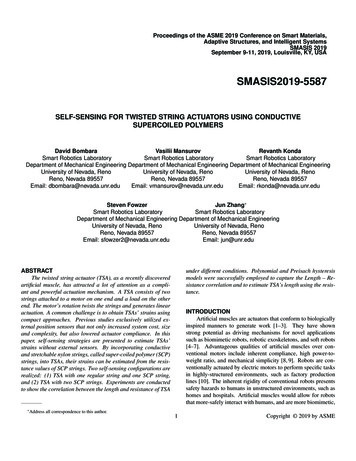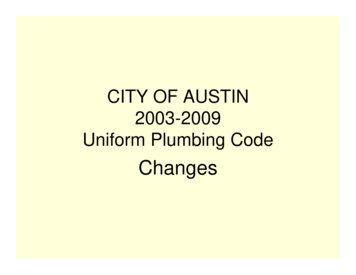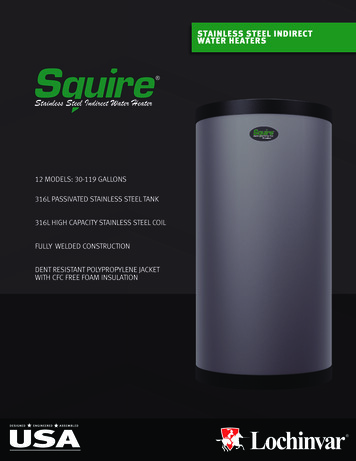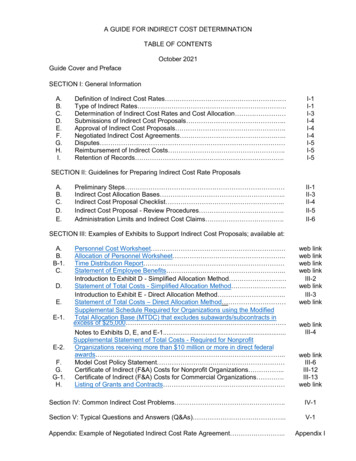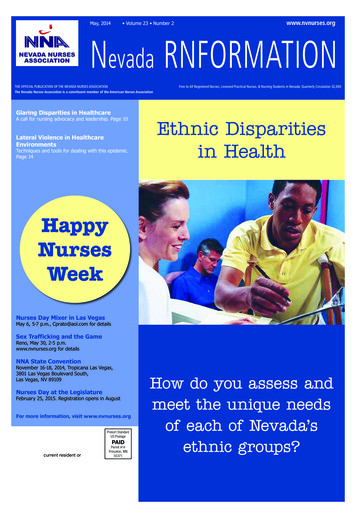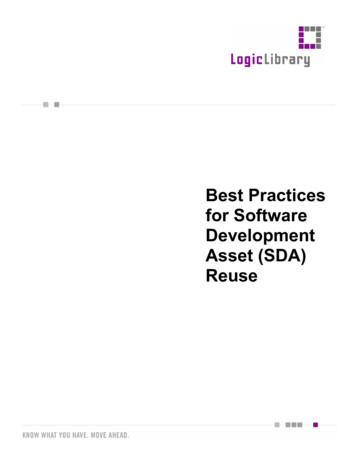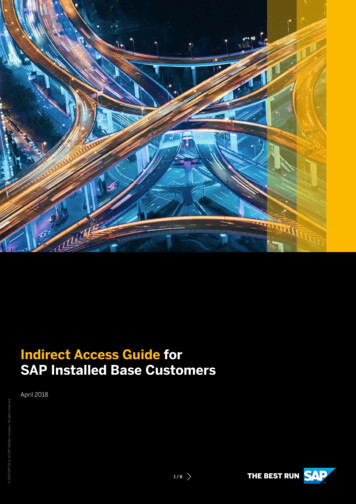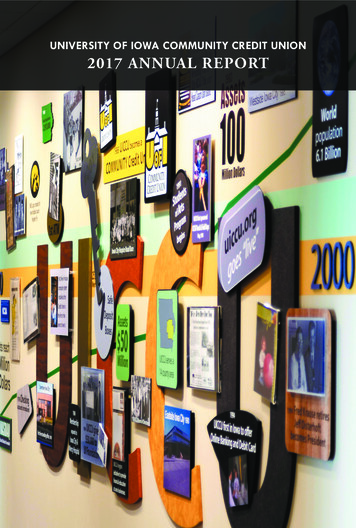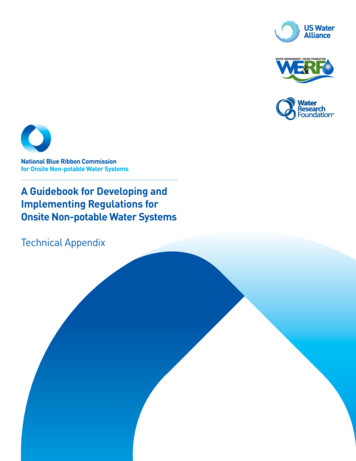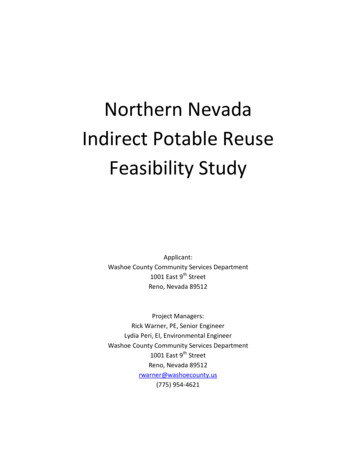
Transcription
Northern NevadaIndirect Potable ReuseFeasibility StudyApplicant:Washoe County Community Services Department1001 East 9th StreetReno, Nevada 89512Project Managers:Rick Warner, PE, Senior EngineerLydia Peri, EI, Environmental EngineerWashoe County Community Services Department1001 East 9th StreetReno, Nevada 89512rwarner@washoecounty.us(775) 954-4621
Table of ContentsExecutive Summary. 1Study Description . 2Feasibility Study Vicinity Map . 3Scope and Responsibilities. 4Project Development and Rationale . 4Community Engagement. 4Nevada Regulatory Framework . 5Pilot Testing Treatment Technologies . 6Demonstration Project. 6Geotechnical Investigations. 7Funding. 7Schedule. 9Discussion. 9Key Regional Team Members . 9Biographies. 10Evaluation Criteria. 11E.1.1 Evaluation Criterion 1 – Statement of Problems and Needs . 11E.1.2 Evaluation Criterion 2 – Water Reclamation and Reuse Opportunities . 12E.1.3 Evaluation Criterion 3 – Description of Potential Alternatives . 13E.1.4 Evaluation Criterion 4 – Stretching Water Supplies. 15E.1.5 Evaluation Criterion 5 – Environment and Water Quality . 15E.1.6 Evaluation Criterion 6 – Legal and Institutional Requirements . 16E.1.7 Evaluation Criterion 7 – Renewable Energy and Energy Efficiency . 16E.1.8 Evaluation Criterion 8 – Watershed Perspective . 17Letters of Project Support. 18Truckee Meadows Water Authority . 18Northern Nevada Water Planning Commission. 19Study Budget . 20Budget Narrative and Funding Plan . 20Budget Proposal . 21
Northern NevadaIndirect Potable Reuse Feasibility StudyJanuary 2017Executive SummaryA Reno, Nevada regional team (Regional Team) consisting of eight public agencies isjointly conducting a feasibility study (Study) to evaluate whether the State of Nevada’snewly adopted “A ” reclaimed water category offers significant water resourcemanagement benefits including improving efficiency, providing flexibility during periodsof water scarcity, and diversifying the region’s water supply portfolio. Category A reclaimed water quality requirements meet all Federal and State of Nevada drinkingwater standards and is intended for indirect potable reuse. It is anticipated A quality willbe achieved from a combination of advanced water treatment processes and soil-aquifertreatment and storage.The Study consists of multiple elements including a project rationale and justificationanalysis, regulatory formulation, public engagement, advanced water treatmenttechnology pilot testing, geotechnical investigations, and field-scale indirect potable reusedemonstration trials. A specific geographic region in the Reno, NV, referred to as theNorth Valleys will serve as the Study boundary condition. The Study will likely take 3-to-4years and approximately 7 million to complete.Bureau of Reclamation Title XVI funding would enable a substantially more robust analysisrelating to the project rationale and justification work occurring in calendar year 2017 andearly 2018, specifically enhancing the Study in the following focus areas: Developing a water market value impact study. Evaluating methods acceptable to the Nevada State Water engineer to create andaccount for a “new” A water right. Evaluating if indirect potable reuse enables the region’s water resource portfoliowith greater resiliency with respect to climate change. Evaluating less energy intensive water treatment technologies suitable for potablereuse, compared to reverse osmosis.The above listed focus areas will complement the project rationale and justification workalready envisioned. Developing knowledge in these focus areas will create a body of workthat can be easily transferrable to future projects in Nevada and other states.1
Northern NevadaIndirect Potable Reuse Feasibility StudyJanuary 2017Study DescriptionA Reno, Nevada regional team (Regional Team) of eight public agencies is jointlydeveloping a feasibility study (Study) to evaluate whether the State of Nevada’s newlyadopted “! ” reclaimed water category offers significant water resource managementbenefits. Category A reclaimed water quality requirements meet all Federal and State ofNevada drinking water standards, and is intended for indirect potable reuse (IPR).The Study will consist of multiple elements and will take 3-to-4 years and approximately 7 million to complete. The Regional Team is seeking up to 150,000 from the Bureau ofReclamation funding opportunity number BOR-DO-17-F003, WaterSMART: Developmentof Feasibility Studies under the Title XVI Water Reclamation and Reuse Program for FiscalYear 2017. Title XVI funds would enhance the Northern Nevada Study by facilitating morerobust analysis evaluating water market conditions, water rights, climate change, andwater treatment technologies with low energy consumption.Although IPR alternatives have been included in previous Northern Nevada water masterplanning efforts, IPR was not considered viable largely because there was not a clearregulatory pathway established in Nevada. One of the most comprehensive watermanagement plans developed to date is titled North Valleys Effluent Disposal Options,dated 2005. The plan evaluated numerous water supplies, wastewater treatmentscenarios, and effluent management options for an area located approximately 10 milesnorth of Reno, Nevada, commonly referred to as the North Valleys. The plan continues toserve as a water, wastewater, and reclaimed water roadmap for the region. The NorthernNevada feasibility study is utilizing the North Valleys as its boundary condition.As shown in Figure 1. Northern Nevada Indirect Potable Reuse Feasibility Study VicinityMap, the North Valleys is comprised of four (4) adjacent hydro-geologic basins (ColdSprings, East Lemmon Valley, West Lemmon Valley, and Bedell Flat). Water demands aremet with limited groundwater perennial yields plus the area receives drinking water fromtwo (2) water importation projects. The Truckee Meadows Water Authority, which is amember of the Regional Team, supplies the North Valleys with 3,000 acre-feet annuallypotable water originating from the Truckee River, and another 8,000 acre-feet annuallyfrom Honey Lake, California through a 35-mile pipeline.2
C A L I F O R N I ABEDELL FLATW LEMMON VALLEYNGLOCOLD SPRINGSLVAYLEEECRK COLD SPRINGSWASTEWATER RECLAMATIONFACILITYE LEMMON VALLEY RENO STEADWASTEWATERTREATM ENT FACILITY0Legend Wastewater Treatment FacilityFIGURE 1Northern Nevada Indirect Potable ReuseFeasibility Study Vicinity MapFish Springs Water Importation PipelineBureau of Reclamation WaterSmart GrantPotential Recharge SitesBOR-DO-17-F003Truckee Meadows Water AuthorityHydrobasin0.75 1.534.56MilesNotes: The Scale and configuration of all Informationshown hereon are approximate only and are not intendedas a guide for design or survey work. Reproduction isnot permitted without prior written permission from theWashoe County Community Services Department.January, 2017µWashoe County Community Services DepartmentEngineering &Capital Projects DivisionUtility Division3
Scope and ResponsibilitiesAlthough the potential use of A reclaimed water to augment groundwater sources inNorthern Nevada is viewed favorably by water managers, the Regional Team’s Study iscrafted to more fully develop an understanding of the social, economic andenvironmental elements.The Study will be conducted and drafted to meet the requirements of a feasibility study asdefined under section 1604 of Pub. L. 102-75, and will conform to the suggested outlinefound in Section 4.B of the Bureau of Reclamation (BOR) Title XVI Feasibility StudyDirectives and Standards. Washoe County will be the lead agency and designated projectsponsor with respect to the BOR funding opportunity. Funding from the Bureau ofReclamation would enable a substantially more robust analysis relating to the projectrationale and justification work occurring in calendar year 2017, specifically enhancing thewater markets evaluation; water rights; climate change; and low energy water treatmentsolutions.Project Development and RationaleCrafting a triple bottom line analysis unique to the Reno, Nevada area is envisioned tohelp align the Study activities, and more clearly articulate the project purpose, goals, andmetrics to the public and policy makers in the Northern Nevada community. Fielddemonstration-scale projects are intended to prove IPR planning concepts, measuretreatment technology performance, and verify ability to meet regulatory compliance.Community EngagementThe Northern Nevada Study embraces approaches to include community engagement inthe local decision making processes. The Study presently includes communityengagement activities that can be described as shorter-term and longer-term initiatives.A short-term communication plan for calendar year 2016 was developed to assist localagency staff communicate predominately to local jurisdiction councils and commissions.Throughout the Study period, a comprehensive community engagement plan will bedeveloped to engage the general public for the purpose of informing and offeringengagement opportunities for the public.The foundational principles of the Regional Team’s community engagement work relatesto creating “agency legitimacy” – defined as specific and authentic actions a public agencyinitiates to gain the trust and acceptability from the public. Agency legitimacy is moreimportant as communities consider reuse projects, particularly potable water reuse.Reuse projects have often been met with public opposition, despite having proven thatthe technology and water quality meet or exceed drinking water standards. Oftentimes,4
technical professionals such as engineers and scientists believe the public will accept newtechnologies when it is provided with information through marketing and publiceducation. Such outreach efforts need be authentic to achieve public support. Researchshows three levels of legitimacy need to be addressed to have a successful project.Nevada Regulatory FrameworkIn December 2016, following a comprehensive two year state-wide collaborative process,the State of Nevada adopted revised reclaimed water regulations, which for the first timeestablishes a regulatory framework for implementing indirect potable reuse forgroundwater augmentation. The newly adopted Nevada regulations permit two methodsof indirect potable reuse:1) Utilizing infiltration basins receiving Nevada Class A reclaimed water, as shownin Figure 2, which is the highest category for unrestricted non-potable uses.2) Aquifer storage and recovery utilizing Nevada Class A reclaimed water, asshown in Figure 3, which is achieve by advanced water treatment processes andsuitable for direct injection to groundwater aquifers.Figure 2 Nevada Indirect Potable Reuse through Infiltration BasinsFigure 3 Nevada Indirect Potable Reuse through Aquifer Injection5
Pilot Testing Treatment TechnologiesThe Northern Nevada Study includes advanced water treatment technology pilot testingconducted in collaboration with the Water Environment and Reuse Foundation (WE&RF),Project 15-10. Focal area for WE&RF 15-10 is optimizing Ozone Biological ActivatedCarbon (O3-BAC) systems for trace organic constituent removal. WE&RF 15-10 is beingjointly funded by WE&RF, American Water, Stantec Consulting, and Washoe County.Figure 4 WE&RF Project 15-10 Oxelia Pilot Unit from Xylem.Demonstration ProjectA cornerstone of the feasibility phase activities is a 50-to-100 gallon per minute (GPM)demonstration-scale advanced water treatment facility. Two (2) demonstration sitelocations are presently planned. One demonstration is investigating the infiltration basinapproach, while the second demonstration project is utilizing “advanced watertreatment” (i.e O3-BAC and RO, followed by advanced oxidation processes likelyconsisting of ultra-violet light and peroxide. Demonstration-scale trailers are depicted inFigure 5Figure 5 Illustration showing likely Demonstration-scale trailers configuration.The Regional Team has contracted with Dr. Krishna Pagilla, Professor and EnvironmentalEngineering Program Director at the University of Nevada, Reno to operate thedemonstration project for performance, reliability, and ability to robustly meet Nevada’sregulations.6
Geotechnical InvestigationsClassifying hydrogeologic characteristics through groundwater modeling and fieldinvestigations will assist with sizing the demonstration project advanced treatment unitsas well as determining the suitability of aquifer recharge at each potential site. TheRegional Team’s efforts will be complimented from experts at the University of Nevadaand the Nevada Desert Research Institute. Near-term options for demonstrating aquiferrecharge within the Study boundary include: Cold Springs – utilizing existing infiltration basins at the Cold Springs WaterReclamation Facility to demonstrate soil-aquifer treatment and recovery. Stead/Lemmon Valley – construct injection and recovery wells demonstratingaquifer storage and recovery. Bedell Flat – potential site for longer term storage/water banking full scaleimplementation.FundingA multi-year budget for the Study is presented in Table 3 Northern Nevada FeasibilityStudy Budget. The Regional Team is seeking up to 150,000 from the Bureau ofReclamation funding opportunity number BOR-DO-17-F003, WaterSMART: Developmentof Feasibility Studies under the Title XVI Water Reclamation and Reuse Program for FiscalYear 2017. Bureau of Reclamation funding would enable a substantially more robustanalysis relating to the project rationale and justification work occurring throughout 2017and the early part of 2018.As illustrated in Table 1, local matching funds would come from Washoe County. WashoeCounty’s contributions are cash, with funds allocated from Washoe County’s regionalreclaimed water funds, which are supported by reclaimed water privilege connection feesand user fees. Washoe County’s 50-percent matching funds ( 150,000) are from cash onhand, and do not include or require any commitments from other local, State of Nevada,or Federal contributions. Table 2 - Proposal Bureau of Reclamation (Funded ProjectActivities) Budget illustrates the preliminary activity level budget for Washoe Countypersonnel and for consultant experts.Table 1 Summary of Non-Federal and Federal Funding SourcesFUNDING SOURCESAMOUNTNon Federal Entities1. Washoe County 150,000*Non-Federal Subtotal 150,000Other Federal Entities1. Not ApplicableREQUESTED RECLAMATION FUNDING 150,000*In-kind contribution7
Table 2 Proposal Bureau of Reclamation (Funded Project Activities) BudgetTable 3 Northern Nevada Feasibility Study BudgetBUDGET ITEM DESCRIPTIONTOTAL COST1. Project Development 305,0002. Community Outreach 160,0003. Regulatory Framework 65,0004. Pilot Testing / Advanced Water Treatment Technologies 2,389,0005. Demonstration Project 2,330,0006. Hydrogeological Investigations 1,490,000 6,739,000TOTAL ESTIMATED PROJECT COSTS8
ScheduleThe Northern Nevada agencies anticipate feasibility study activities to extend through2020. BOR funded activities will occur and be completed with other Project RationalActivities – within 18 months to comply with the funding requirements.Table 4 Northern Nevada Feasibility Study Schedule2016Feasibility Phase Activates20172018201920202021Q1 Q2 Q3 Q4 Q1 Q2 Q3 Q4 Q1 Q2 Q3 Q4 Q1 Q2 Q3 Q4 Q1 Q2 Q3 Q4 Q1 Q2 Q3 Q4Project DevelopmentCommunity EngagementProject RationalRegulatory FrameworkPilot TestingHydrogeologic WorkBuild Demonstration ScaleEquipmentDemonstration Scale Infiltration BasinDemonstration Scale Aquifer Storage and RecoveryReporting ResultsStart ActivityIn Progress WorkEnd ActivityDiscussionThe Regional Team has developed a collaborative and comprehensive feasibility approachwhich includes staff from eight regional water agencies, researches from the University ofNevada, international experts, and water research organizations. Funding from theBureau of Reclamation would enable a substantially more robust analysis relating to theproject rationale and justification work occurring in calendar year 2017, specificallyenhancing Regional Team’s Study in the following focus areas: Developing a water market value impact study. Evaluating methods acceptable to the Nevada State Water engineer to create andaccount for a “new” ! water right. Evaluating if indirect potable reuse enables the region’s water resource portfoliowith greater resiliency with respect to climate change. Evaluating less energy intensive water treatment technologies suitable for potablereuse, compared to reverse osmosis.Key Regional Team MembersRegional Team members responsible to deliver the overall Northern Nevada RegionalFeasibility Study include the professionals listed below. Not shown is approximatelytwenty others that have significant leadership on key feasibility phase activities. TheNorthern Nevada effort is truly a large and effective collaboration, which has developed awork plan to achieve success.9
Rick Warner, P.E.Washoe CountyRick Warner, P.E. is the 2016-17 President of the Water Environment Federation(WEF), an international organization of water quality professionals headquartered inAlexandria, Va. Rick also presently serves on the Board of Directors of the WaterEnvironment and Reuse Foundation. In addition, he is a senior engineer for theWashoe County (Nevada) Community Services Department. In that role he isresponsible for planning, design, and construction for regional water resourcerecovery and recycled water projects. Rick is a registered professional engineer in thestate of Nevada.Lydia Peri,Washoe CountyLydia Peri is an Environmental Engineer with the Washoe County (Nevada)Community Services Department. Lydia earned a bachelor’s in ecohydrology from theUniversity of Nevada, Reno in 2011 and earned a dual master’s in hydrogeology andcivil and environmental engineering in 2015 also from the University of Nevada, Reno.She recently accepted a position as a Ph.D. candidate in the EnvironmentalEngineering Program with Dr. Krishna Pagilla at the University of Nevada, Reno. Herwork with the University will primarily focus on the hydrogeologic investigations forthe Northern Nevada potable reuse initiative.Krishna Pagilla, Ph.D., P.E., BCEEUniversity of Nevada, RenoKrishna Pagilla, Ph.D., P.E., BCEE is a Professor and Environmental EngineeringProgram Director at the University of Nevada, Reno. Prior to relocating to Reno, Prof.Pagilla was a professor of Environmental Engineering at the Illinois Institute ofTechnology and is a licensed engineer in California and Illinois. He is an AssociateEditor of Water Environment Research and is a Fellow of both Water EnvironmentFederation (WEF) and International Water Association (IWA). He has receivednumerous awards for his work including the Harrison Prescott Eddy Medal from WEFin 2011 and Bill Boyle Outstanding Education Award from the Central States WaterEnvironment Association.Laura Haak,University of Nevada, RenoLaura Haak is a Ph.D. student in Environmental Engineering at the University ofNevada, Reno. She completed her M.S in Environmental engineering and B.S. inMechanical Engineering from Illinois Institute of Technology. Her research focuses onthe development of a decision making tool for water resource management andplanning to improve water security at a regional scale. This research utilizes a holisticmodeling approach by incorporating socio-economic, hydrologic, and biophysicalimpacts of water management and infrastructure scenarios to asess net socialbenefits generated by local water resources.Vijay Sundaram, P.E.Water Reuse Technology LeaderVijay Sundaram, P.E. leads the Stantec water reuse technology practice and isStantec’s national technical lead for water regulations and compliance. Vijay has wellrounded experience in designing and evaluating processes for municipal andindustrial water and wastewater treatment, including work with advanced treatment,water recycling, and energy optimization. of the Ozone-BAC technology for potablereuse.10
Northern NevadaIndirect Potable Reuse Feasibility StudyJanuary 2017Evaluation CriterionBureau of Reclamation Title XVI funding would enable a robust analysis relating to the projectrationale and justification work occurring in calendar year 2017 and early 2018, specificallyenhancing the Northern Nevada Indirect Potable Reuse Feasibility Study in the following focusareas: Developing a water market value impact study.Evaluating methods acceptable to the Nevada State Water engineer to create andaccount for a “new” A water right.Evaluating if indirect potable reuse enables the region’s water resource portfolio withgreater resiliency with respect to climate change.Evaluating less energy intensive water treatment technologies suitable for potablereuse, compared to reverse osmosis. Evaluation Criterion 1—Statement of Problems and NeedsA Reno, Nevada regional team (Regional Team) consisting of eight public agencies is jointlyconducting a feasibility study (Study) to evaluate whether the State of Nevada’s newly adopted“A ” reclaimed water category offers significant water resource management benefits.BOR funding support more critical review of regional water resource management alternatives,particularly with respect to if indirect potable reuse can have a positive impact upon theregion’s water portfolio for drinking water resiliency or addition recreational andenvironmental benefits.Statement of Problem Discussion.Although IPR alternatives have been included in previous Northern Nevada water masterplanning efforts, IPR was not considered viable largely because there was not a clear regulatorypathway established in Nevada. One of the most comprehensive water management plansdeveloped to date is titled North Valleys Effluent Disposal Options, dated 2005. The planevaluated numerous water supplies, wastewater treatment scenarios, and effluentmanagement options for an area located approximately 10 miles north of Reno, Nevada,commonly referred to the North Valleys. The plan continues to serve as a water, wastewater,and reclaimed water roadmap for the region.Water resources within the Truckee River watershed are primarily derived from snowpackaccumulated during the winter season. Although the regional effects of climate change areuncertain, the region expects to incur more frequent or extended drought periods and a11
transition from river flows derived from melting snowpack to rainfall. The potential shift inprecipitation patterns from snowfall to rainfall may have dramatic impacts on future waterplanning due to effects on water storage and quality; currently surface water supply primarilyoriginates from snowmelt during spring and summer months. Concern over quantity andquality of water supplies within the region also drives competition between downstream andupstream users that rely largely on the Truckee River to support sensitive ecologies, agriculturaluses, industrial development, and diverse communities.Water resources within the Truckee River watershed are fully allocated and several basinswithin the region are closed, relying on groundwater flows, inter-basin transfers of surfacewater from the Truckee River, and imported water to meet water demand. If the waterportfolios of these closed-basins are not expanded, imported water may play an increasing rolein satisfying water demand. However, the local water authority has limited control overimported water resources, and it is also an expensive resource that requires significantelements to manage and is associated with a large carbon footprint due to pumpingrequirements.The North Valleys is comprised of four (4) adjacent hydro-geologic basins. Water demands aremet with limited groundwater perennial yields plus the area receives drinking water from two(2) water importation projects. The Truckee Meadows Water Authority, which is a member ofthe Regional Team, supplies the North Valleys with 3,000 acre-feet annually potable wateroriginating from the Truckee River, and another 8,000 acre-feet annually from Honey Lake,California through a 35-mile pipeline.To address and consider possible impacts from climate change, it is likely that the Water for theSeasons (WftS) program and the Desert Research Institute (DRI) will collaborate with theRegional Team on this portion of the feasibility study. WftS is a partnership between NorthernNevada scientists, water managers and water right holders in the Truckee-Carson River Systemto investigate new strategies and solutions for addressing extreme climate events such asdroughts and floods.Evaluation Criterion 2—Water Reclamation and Reuse OpportunitiesThe feasibility study will examine water resource availability, quality, and other characteristicsthroughout the watershed, and targeting key basins that are focal points of residential,economic and ecosystem water demands for review of water security over the next 20 years.Through this feasibility study, methods acceptable to the Nevada State Water engineer tocreate and account for a “new” A water right will be evaluated.BOR funding would also support water markets study to for the North Valleys that couldpotentially be applied regionally. The scope of this work is not fully developed, although isintended to provide a potential mechanism to promote efficient water uses and minimize theeconomic impacts of periodic drought conditions. This project activity would provide a case12
study analysis of water markets to inform the Regional Team of potential options fordevelopment of an expanded water market as an alternative or companion to otheropportunities to improve regional water supply conditions. Conceptually, the water marketswork would consider the regulatory conditions, water supply and demand, marketparticipation, and water pricing and cost of alternatives.Water Reclamation and Reuse Opportunities Discussion.The examination will consider trends in population growth and commercial development at keybasins, specifically the North Valleys, and regionally. Potable reuse of water may help tostabilize and better distribute water values across the Truckee River watershed by helping todecouple water supply from uncertain precipitation conditions. Much like reservoir and aquiferstorage, potable reuse adds a source of water that is more secure than annual precipitation:the volume of water that can be treated and stored is not only dependent on annualprecipitation. With greater security in potable water resources, the use of water may alsobecome more efficient by encouraging more diversified economic uses of reclaimed waterresources than purple pipe programs may achieve. Additionally, improved planning of availablewater resources can aid in management of instream surface water flows to meet the needs ofsensitive ecosystems.To correlate changes in water allocations under stat
The Northern Nevada Study includes advanced water treatment technology pilot testing conducted in collaboration with the Water Environment and Reuse Foundation (WE&RF), Project 15-10. Focal area for WE&RF 15-10 is optimizing Ozone Biological Activated Carbon (O 3-BAC) systems for tr
